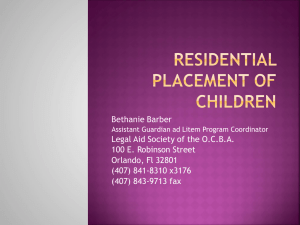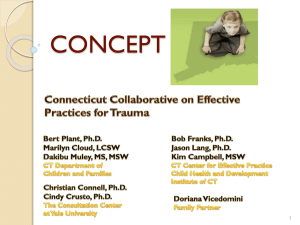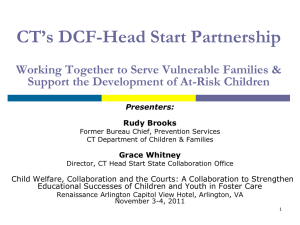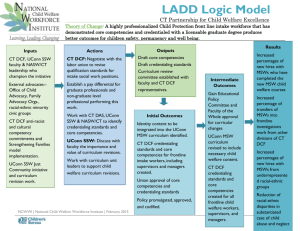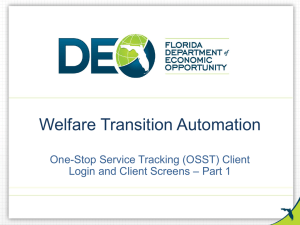1 2 - Purdue University
advertisement
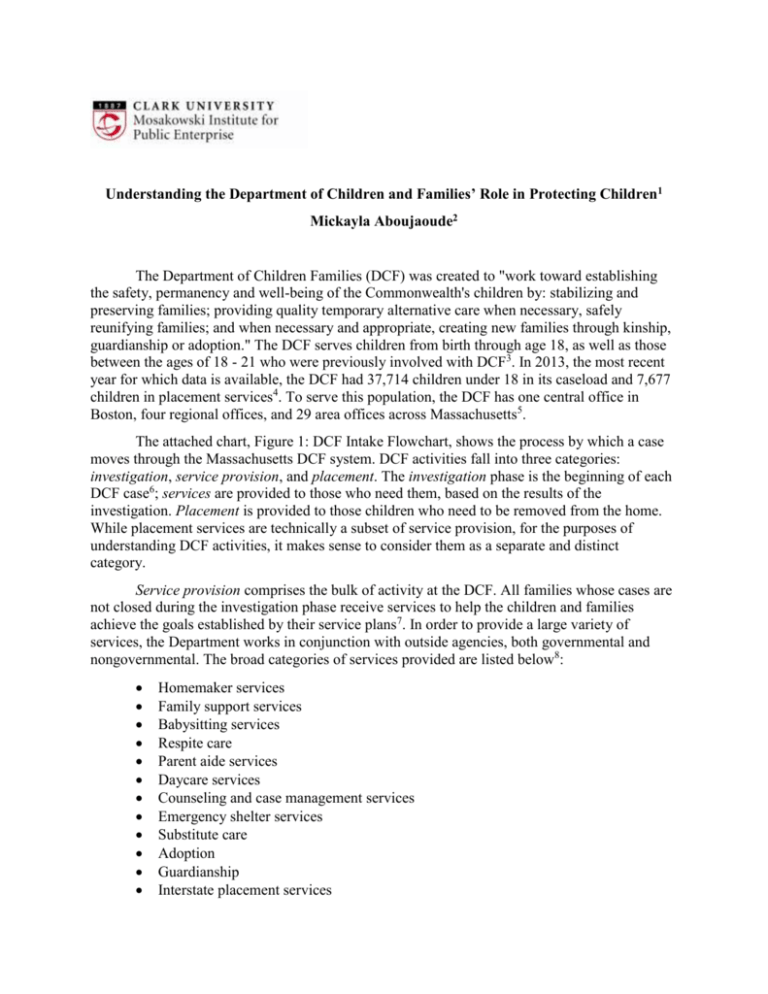
Understanding the Department of Children and Families’ Role in Protecting Children1 Mickayla Aboujaoude2 The Department of Children Families (DCF) was created to "work toward establishing the safety, permanency and well-being of the Commonwealth's children by: stabilizing and preserving families; providing quality temporary alternative care when necessary, safely reunifying families; and when necessary and appropriate, creating new families through kinship, guardianship or adoption." The DCF serves children from birth through age 18, as well as those between the ages of 18 - 21 who were previously involved with DCF3. In 2013, the most recent year for which data is available, the DCF had 37,714 children under 18 in its caseload and 7,677 children in placement services4. To serve this population, the DCF has one central office in Boston, four regional offices, and 29 area offices across Massachusetts5. The attached chart, Figure 1: DCF Intake Flowchart, shows the process by which a case moves through the Massachusetts DCF system. DCF activities fall into three categories: investigation, service provision, and placement. The investigation phase is the beginning of each DCF case6; services are provided to those who need them, based on the results of the investigation. Placement is provided to those children who need to be removed from the home. While placement services are technically a subset of service provision, for the purposes of understanding DCF activities, it makes sense to consider them as a separate and distinct category. Service provision comprises the bulk of activity at the DCF. All families whose cases are not closed during the investigation phase receive services to help the children and families achieve the goals established by their service plans7. In order to provide a large variety of services, the Department works in conjunction with outside agencies, both governmental and nongovernmental. The broad categories of services provided are listed below8: Homemaker services Family support services Babysitting services Respite care Parent aide services Daycare services Counseling and case management services Emergency shelter services Substitute care Adoption Guardianship Interstate placement services 2 Special education services Removal from the Home (Foster Care & Adoption) Foster care organizations are one example of how outside non-governmental agencies come into play. While the DCF has its own foster homes, intensive foster care is supplied by external organizations. These outside agencies are tailored to suit the needs of children who have greater behavioral needs and/or disabilities. The foster parents who work for the external agencies go through the same approval process as typical DCF foster parents, but then can also receive additional training from the agency. Placement. When a child or family is involved with the DCF, it may be sometimes necessary to remove the child from his/her home. There are two methods by which a child would be removed from the home. The first is when the child is judged to be in immediate danger. If this is the case, courses of action include emergency removal and non-emergency court-ordered removal. Emergency removal happens when a social worker, upon observing the child, makes the following determinations9: a) That a condition of serious abuse or neglect (including abandonment) exists; b) That, as a result of that condition, removal of the child is necessary in order to avoid the risk of death or serious physical injury of the child; and c) That the nature of the emergency is such that there is inadequate time to seek a court order for removal. A court order must be obtained immediately following an emergency removal. Non-emergency court-ordered removal is a somewhat lengthier process wherein a social worker must first get judicial approval in order to remove the child from his/her home10,11. In order to obtain a court order, a social worker must demonstrate that the child is experiencing at least one of the following: a) The child is without necessary and proper physical or educational care and discipline; b) Is growing up under conditions or circumstances damaging to the child’s sound character development; c) Lacks proper attention of the parent, guardian with care and custody, or custodian; or d) Has a parent, guardian, or custodian who is unwilling, incompetent, or unavailable to provide any such care, discipline, or attention. Prior to the hearing, the legal parents are invited to present their arguments against committing the child to DCF custody, and the child may be summoned before the court to allow the judge to make an informed decision12. The second method for removal is when the family voluntarily places the child in the care of the Department. This can happen either by way of the family voluntarily placing the child in foster care or by surrender for adoption. With a voluntary placement, the child temporarily stays in foster care while remaining in the legal custody of their family13,14,15. When placing a child outside of the home, the DCF considers, consistent with the best interests of the child, the following placement resources in the following order16: 3 Placement with kinship family Placement with a child-specific family Placement in a family foster care home where the child was previously placed Placement in family foster care Placement in a shelter/short term program or group home Placement in community residential care Note that 85% of all children receiving DCF services remain in their home17. 1 This paper and the attached Figure draw upon language found on DCF webpages and in DCF regulations (110 CMR). The author does not claim ownership over the information provided in these documents. 2 Class of 2017, Clark University. Please send comments to MosakowskiInstitute@clarku.edu. 3 http://www.mass.gov/eohhs/gov/departments/dcf/about-the-department-of-children-and-families.html 4 Massachusetts Department of Children and Families Annual Profile 2013 5 See Endnote 3 6 For more information, see the following: 110 CMR 4.00: Intake http://www.mass.gov/eohhs/gov/departments/dcf/child-abuse-neglect/screening.html http://www.mass.gov/eohhs/docs/dcf/can-mandated-reporters-guide.pdf http://www.mass.gov/eohhs/docs/dcf/can-family-guide.pdf 7 For information, see 110 CMR 6.00: Service Plans and Case Reviews 8 110 CMR 7.00: Services 9 110 CMR 4.29: Emergency Removal 10 http://www.mass.gov/eohhs/docs/dcf/can-family-guide.pdf 11 http://www.mass.gov/eohhs/gov/departments/dcf/foster-care/foster-parenting/dss-foster-care-faqs.html#4 12 MGL Ch 119 § 24 13 110 CMR 4.10: Voluntary Placement Agreements - Execution 14 110 CMR 2.00: Glossary 15 110 CMR 4.15: Surrenders for Adoption 16 110 CMR 7.101: Out-of-Home Placements 17 See Endnote 3

